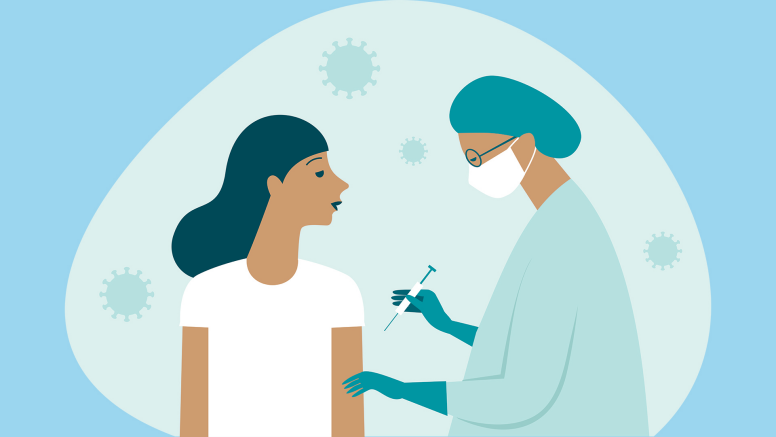News & Stories
Combining analytical horsepower with willpower to improve the world

At the end of his first year as a doctoral student in operations at UNC Kenan-Flagler Business School, RJ Niewoehner began a research project investigating how medical providers might most effectively be encouraged to administer more flu shots.
He worked “side-by-side throughout this project” with Bradley Staats, professor of operations and faculty director of the Center for the Business of Health. During fall 2019, Niewoehner and Staats wrote about their research in Harvard Business Review and assembled a manuscript of their findings that are set to be published in Management Science.
“Our intervention worked – we saw a 6% increase in flu vaccines for all clinics that received any kind of nudge,” says Niewoehner.
Niewoehner’s curiosity, “keen understanding of the practical issues physicians face and rigorous empirical training” and perseverance have been essential to the project’s success, says Staats.
 “Conducting research means discovering new things, which means frequently getting it wrong or encountering surprises,” Staats says. “The final project shows the power of combining analytical horsepower with willpower to understand and try to improve the world around us.”
“Conducting research means discovering new things, which means frequently getting it wrong or encountering surprises,” Staats says. “The final project shows the power of combining analytical horsepower with willpower to understand and try to improve the world around us.”
Here Niewoehner talks about their research, including how the study findings might provide valuable knowledge related to COVID-19.
Please tell us about your research with Bradley Staats about how to increase the number of flu vaccinations provided each year.
In this study, we worked with a vaccine management company called VaxCare to specifically look at how physicians and other medical providers offer influenza (or “flu”) vaccines to patients who visit their office. Most people are familiar with the flu, but many don’t know that in 2019 more than half a million people were hospitalized with the flu and more than 30,000 people died because of it. In fact, about one in every 10 people got some version of the flu last year. And though there’s lots of ways of preventing the flu, the vaccine continues to be the best protection. But despite the CDC’s insistence that everyone over 6 months of age get their flu shot every year, the adult vaccination has been stuck at 40% for a decade.
The traditional approach to fixing this problem focuses on getting patients to seek out their healthcare providers to ask for the shot. But studies using this approach might change patient beliefs about the vaccine without affecting patient behavior. For example, these studies might convince a patient that getting the vaccine is a good idea, but they can’t show that patients then go out and get the shot that season. The truth is changing patient behavior is really hard!
We tackled the problem from a different perspective, instead nudging providers to recommend the vaccine more often. To get these healthcare providers to offer more shots, with VaxCare’s help, we provided them with either financial incentives or performance feedback. Our intervention worked – we saw a 6% increase in flu vaccines for all clinics that received any kind of nudge. Surprisingly, we also found that the performance feedback worked better than the financial incentives. We think there is a lot of opportunity here, even outside healthcare, to use performance rankings to improve individual productivity.
As we look ahead to a flu season in the time of COVID-19, are there possible associations between your research findings on flu vaccines and our response to the COVID-19 pandemic?
We see at least two relevant linkages between our work and the COVID-19 pandemic. First, our work ultimately focuses on how to convince more people to get their flu vaccination, as we know from other studies that doctor-recommended vaccines yield high acceptance rates among patients. With a greater percentage of the population vaccinated against the flu, there will be fewer flu patients and thus fewer patients in general occupying medical resources (emergency room beds, medical appointments, etc.). Fewer flu patients serves to flatten the curve, thus enabling our medical system to more effectively respond to instances of COVID-19 as they arise.
Second, there is definite interest in examining behavior surrounding a “bundle” of vaccinations, where patient interest in one vaccination might spill over into greater interest in another as well. For example, consider the possibility of a COVID vaccine becoming available in the next 18 months. Healthcare providers will not need to convince their patients to come in and get that vaccine – the line will be out their door! But we think this might be a perfect opportunity to simultaneously offer patients a flu vaccine. Given our findings, such an approach might drastically improve the overall population vaccination rate with significant implications for public health, in general. Although the COVID-19 pandemic presents real challenges, I am optimistic that our scientific community will maximize this opportunity to innovate and respond to these challenges.
What interests you the most about the process of discovery, and how is this work preparing you for your career?
To me, the most intriguing aspect of discovery truly is the threat of the unknown. No scientific study is launched with the hopes of failure, and yet a project’s failure or even a lack of a result is a discovery in its own right. When we launched the flu vaccine study, we suspected that healthcare providers would respond to incentives and feedback, but we didn’t know for sure. We certainly would not have predicted that performance feedback might work even better than financial incentives. That truly was a discovery, and it is this unknown aspect of discovery that both excites me and keeps me awake at night.
For career preparation, as a budding academic, I aspire to the role of both educator and researcher. This project has provided me with an understanding of the fundamentals of conducting successful research, covering everything from designing a field study to revising a manuscript. The experience from this project serves to lay the groundwork for many future successful studies, both in healthcare and beyond.
This article was first published by the Carolina Graduate School magazine.